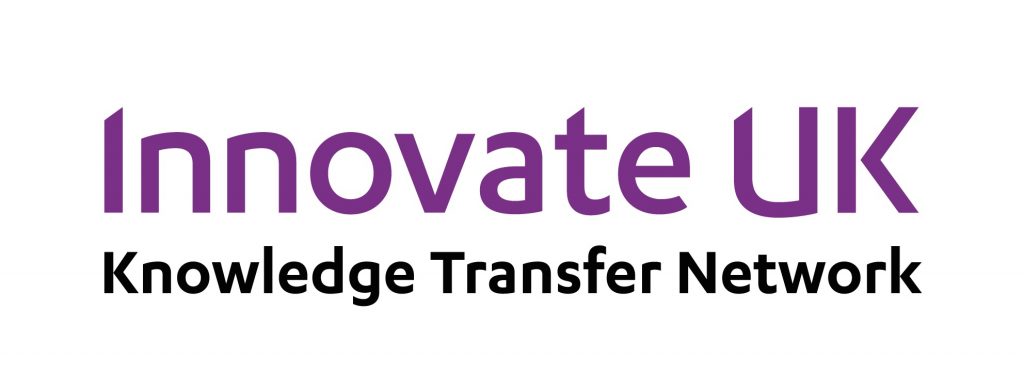Automating Generator Pole Shoe Bolt Inspection and Tightening
The Robotics Innovation challenge competition, delivered in partnership with ORE Catapult and the Knowledge Transfer Network, is supporting GE to identify innovative solutions to innovation challenges. The generator pole shoe bolt connection on the GE Haliade-X units need to be inspected within an interval of 36 months after commissioning is complete. Companies are required to develop a semi or fully autonomous device that is capable to perform the inspection of the pole shoe connection.
Opportunity
Challenge opens
16/09/2019
Challenge closes
29/10/2019
Benefit
1 An introduction from GE Renewable Energy
GE Renewable Energy is a $15 billion business which combines one of the broadest portfolios in the renewable energy industry to provide end-to-end solutions for our customers demanding reliable and affordable green power. Combining onshore and offshore wind, blades, hydro, storage, utility-scale solar, and grid solutions as well as hybrid renewables and digital services offerings, GE Renewable Energy has installed more than 400+ gigawatts of clean renewable energy and equipped more than 90 percent of utilities worldwide with its grid solutions. With nearly 40,000 employees present in more than 80 countries, GE Renewable Energy creates value for customers seeking to power the world with affordable, reliable and sustainable green electrons.
GE Offshore Wind, a GE Renewable Energy business, is headquartered in Nantes, France, and has more than 600 employees in the world (with main offices in France, Spain, Germany, China and the US). GE Offshore Wind serves global markets and is the only offshore wind turbine supplier to have projects in Europe, Asia and the Americas. On March 2018, we announced a strategic investment plan to develop Haliade-X 12 MW, the most powerful offshore wind turbine to-date, to be assembled in Saint-Nazaire, with LM Wind Power blades to be manufactured in Cherbourg. The first prototype is currently being assembled in Rotterdam.
With a projected industry growth from 22 to 153 GW in the next decade, experts believe offshore wind will account for 15% of the global wind industry going forward, and by 2025, offshore wind could represent more than 15% of global wind installed capacity.
- 2 Products & Services - Offshore Wind
Offshore Wind contains 2 main platforms, the Haliade 6MW-150 and Haliade-X, currently the most powerful offshore wind turbine in the world featuring a 12 MW capacity generator (the world’s first), 220-meter rotor, a 107-meter blade designed by LM Wind Power, and digital capabilities.
1.2.1 Haliade 6MW-150
As of today, GE Offshore Wind is the only OEM on all 3 continents, accounting for 1GW of installations (incl. backlog):
- Europe:
- Merkur, DE: 396MW
- Osterild, DK: 6MW
- Belwind, B: 6MW
- LeCarnet, FR: 6MW
- St. Nazaire: 480MW (backlog)
- North America:
- Block Island, US: 30MW
- Asia:
- Fuqing Xinghua Bay, CH: 18MW
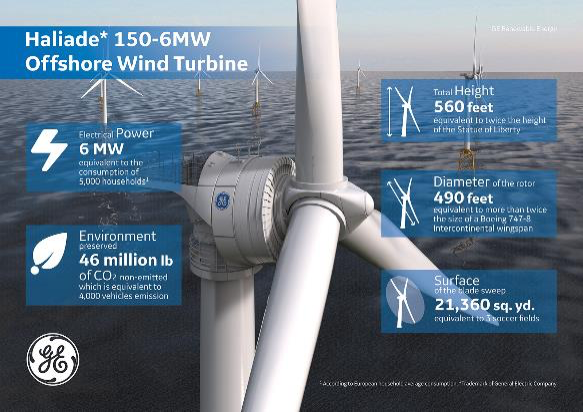
Figure 1 Haliade 6MW-150
1.2.2 Haliade-X 12MW-220
The validation unit of the Haliade-X is going to be installed in Rotterdam, NL for IEC Type certification, besides many other extended tests. The first commercial units will be installed in 2023.
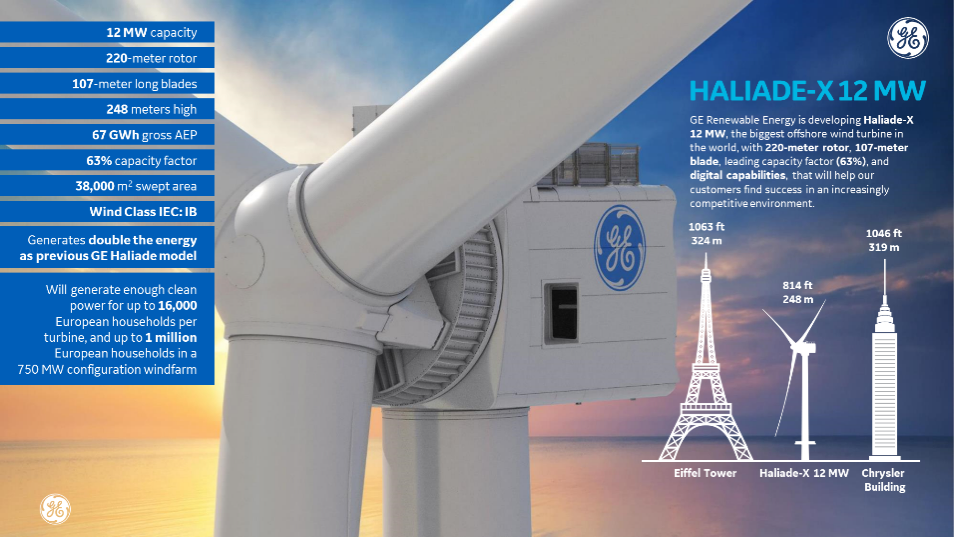
Figure 2 Haliade-X 12MW-220
1.2.3 Service & Digital
1.2.3.1 Wind Energy Turbine Service
Our team provides flexible and customised operations and maintenance support to fit specific customer needs. We offer tiered levels of service offerings ranging from remote monitoring to fully maintaining the customer's plant, as well as a wide range of performance-enhancing upgrades to keep turbines running smoothly. Whether a customer is looking for support with unplanned maintenance or interested in upgrading its farm or fleet with our digital applications, we can meet their needs.
Optimising wind power generation lifetime output for Offshore Wind
The long-term performance potential of a wind farm is only partially determined at the manufacturing and construction stages. The best design and construction will be of little benefit if the operating and maintaining service is not fully optimised. That is why GE operates a global network of local service centres and offers a full range of packages and services in order to:
- Enhance availability
- Improve energy generation
- Optimise component and system lifetime
The key to achieving these objectives lies in highly reliable products combined with effective planned maintenance, resulting in increased production. This is achieved thanks to carefully selected predictive and preventative service activities as well as suitable upgrades and retrofits.
In accordance with our clean power strategy, we always consider profitability and commercial excellence in the wider context of environmental, health and safety (EHS) matters.
Corrective Maintenance consists of repairing breakdowns or performing unscheduled emergency maintenance. Data analyses and equipment control enables us to determine any potential incidents in real-time. In order to minimise the impact of these corrective activities, predictive activities are carried out supported by a stock of spare parts and critical components, stored either at wind farms or in our warehouses.
Additionally, and as a complement to the activities mentioned above, predictive actions such as oil analyses, vibration measurements, and thermography etc. are also performed in order to anticipate any slowly-developing malfunctions to minimise any unforeseen breakdowns.
Finally, preventive maintenance refers to all maintenance actions that are programmed in the wind turbine maintenance manual (operations and regular inspections), which are necessary to guarantee the life of the machines and operation under optimum conditions.
1.2.3.2 Digital Solutions
Our customers’ operational strategy is what drives our digital products and lifecycle solutions. We focused on what matters most to the customer - outcomes that increase revenue, reduce costs, and lower risk. GE does this by applying data-driven insights, expert recommendations, and advanced field services through a single digital asset management platform.
GE combines physical product expertise with an end-to-end renewable energy analytics-based platform. Our renewable energy software and data analytics out-perform the competition because of our deep industry knowledge and hands-on experience. Our models are built on decades of experience operating renewable energy assets around the world, proprietary data, and the internal use and refinement by our services teams.
The Industrial Internet is helping companies reach new levels of productivity and gain a competitive edge. For renewable energy, this means digitising asset management and connecting data for improved reliability, enhancing operations to increase profitability, and innovating new business models to improve performance and scale for growth. But where to start?
GE’s Digital Wind Farm offerings help to deliver a full view of your enterprise with data consolidation and translation. This digital control allows you to take action by turning data from your renewable energy technology into insights through advanced analytics and recommendations—enabling smarter operational teams that keep your fleet running its best.
1.3 Robotics
Robots can be programmed to perform dangerous, dirty and/or repetitive tasks with consistent precision and accuracy. Industrial robots are increasingly used in a variety of industries and applications. They come in a wide range of models with the reach distance, payload capacity and the number of axes.
Inspections and necessary repairs of wind turbines off the coast are currently carried out by a crew of technicians, who face considerable safety risks in the course of their work due to the risks posed by extreme conditions, weather events and the height of the turbines. The process is doubly costly as a result of lost energy production during the period of downtime which must occur so maintenance activity can be carried out; and the daily expense incurred by crew transfer vessels.
In the next years GE Offshore Wind aims to develop robots, which can be used in the following areas:
- Inspection & repairs
- Repetitive tasks
- Confined space
Besides the specific areas of work, the integration of the robotics into the service plan and fleet engineering loop is critical to ensure effective usage of the robotics.
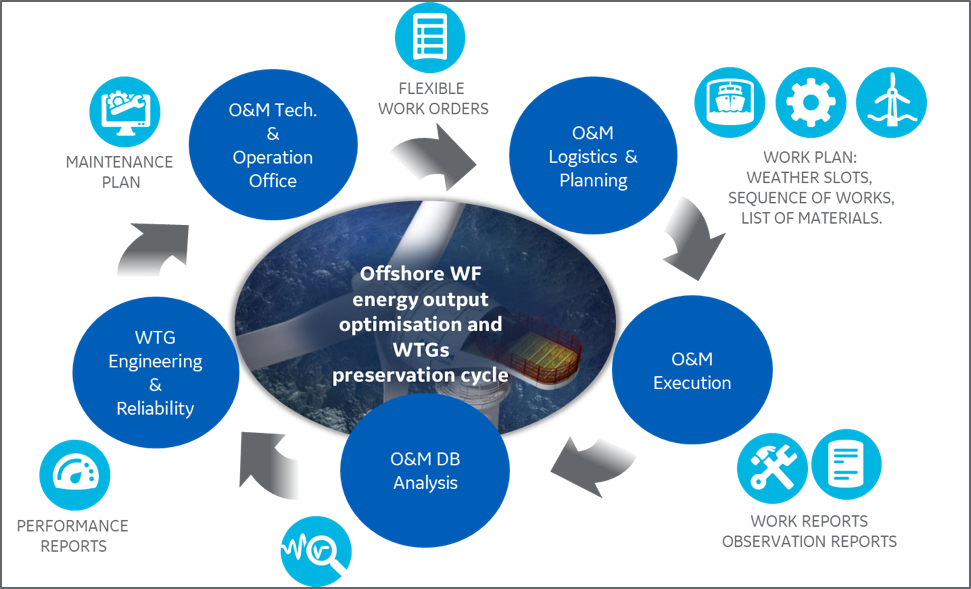
Figure 3 GE service plan and engineering loop
2 Generator Pole Shoe Inspection and Tightening Challenge
The Robotics Innovation challenge competition, delivered in partnership with ORE Catapult and the Knowledge Transfer Network, is supporting GE to identify innovative solutions to innovation challenges. The winning business(es) in this competition will be given a commercial opportunity to deliver their solution to GE Offshore Wind, and to receive support from GE Offshore Wind, the ORE Catapult and the wider UK network. Whilst not limiting the technologies from solution providers, it is expected that solutions would consider innovations from challenges, which are described in the following sections.
Successful applicants will be given an opportunity to pitch to GE Offshore Wind. The package may also include:
- Support from GE Offshore Wind
- Support in the development of a prototype or pilot
- Technical support
- A place at ORE Catapult events
- A potential business collaboration
2.1 Background
The generator pole shoe bolt connection needs to be inspected within an interval of 36 months after commissioning is complete. This task is to be performed outside of the generator housing around its entire circumference. Currently it is performed by a team of three technicians who must rappel from defined anchoring points on top of the generator down to the lower part of the generator as shown in Figure 4. The current approach is to use rope climbers, using a 500Nm manual torque wrench to inspect the bolts. Prior to the torque value check a cap and silicon seal must be removed. This process is very sensitive to weather conditions and thus may experience restrictions causing delays of schedules and induce higher costs. And in addition, adds safety concerns and long execution cycles. The firm seat of these bolt shoes is crucial for the operation and life time of the generator.
GE seeks an inspection method that eases the job by eliminating human resource exposure to rope climbing by applying the highest safety and quality standards and guaranteeing full functionality of components. This may involve robotic technology that operates semi or fully self-sufficiently.
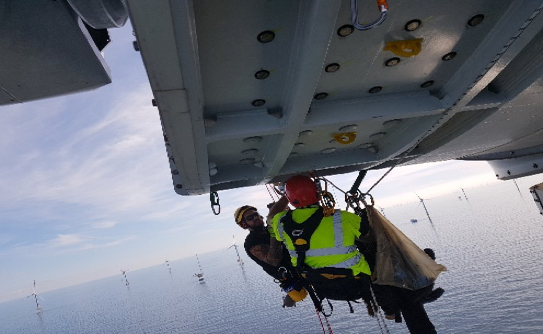
Figure 4 bolt tensioning check lower part of generator
2.2 Scope
Develop a semi or fully autonomous device that is capable of performing the inspection of the pole shoe connection as outlined in section 2.2.1 and meeting the capabilities as under section 2.2.2.
2.2.1 Operational Requirements
- The connection inspection sequence and the number of bolts is to be checked is determined by the design specifications and must be followed. Bolt socket size is specified as 30mm and a reference torque value of 340 NM needs to be applied. The affected number of bolts are 720 if 100% inspection is required.
- Operate semi or fully self-sufficient
- All bolts are sealed by silicon sealant and a cap, both must be removed
- All waste and disposals are carefully collected and do not enter uncontrolled into the environment
- All openings are clean and free of debris
- New silicon seal and cap to be provided and fitted for each bolt in accordance with the specifications issued by design requirements after the tightening check
- For each bolt that needs to be inspected the following shall be recorded and made available in an inspection report that can be uploaded to a PC or other electronic device for further processing
- Determine the exact position on the circumference of the generator
- Record the starting and end torque value of the identified bolt
- Record the degree of bolt movement
- Installation time for the device and associated equipment shall be <30 minutes with a target average cycle time for each connection < 2min (max. 5min), excluding mobilisation and demobilisation
- Operating team shall be limited to 2 technicians for the setup and 1 technician for the operation of the device.
The generator outer surface is made of structural steel and has an anti-corrosion protective coating. This coating shall not be damaged by scratches or peeling while the robot manoeuvres.
2.2.2 Operational Conditions
The device and associated equipment must be capable of operating in harsh offshore conditions and meet the following criteria:
- Waterproof and shock resistant
- Resistant against dust, dirt, grease, oil, glycol
- Minimal maintenance and calibration efforts, e.g. maintenance and calibration shall not be below 12 months with a desired interval of 24 months
- Able to work minimum 12 hours constantly in high humidity outdoor environment with a temperature range of -10°C to +40°C, and best case up to 12m/s wind speed
- Minimal training and educational effort shall be required to operate the device
- If not battery operated, power can be supplied via temporary cables from the turbine’s 230/400V auxiliary power supply system
2.3 IP and Potential Commercial Route
- Prior to any exchange of proprietary information, a non-disclosure agreement shall be in place between any party involved
- Any new developed IP that was born from the innovation challenge shall be subject to a mutual agreement between developer and GE
- Existing background IP associated with a potential solution will remain with Solution Provider(s)
- Any commercial deployment of a transferred solution or newly developed solution, through licensing, joint venture, partnership or direct investment, will be subject to the commercial agreement between the Solution Provider(s) and GE.
2.4 Deployment Timescale
- Launch of the Competition: 16-Sep-2019
- Deadline for applications: 25-Oct-2019
- Selection and notification of finalists: 8-Nov-2019
- F2F meeting/pitch opportunity for finalists: w/c 11-Nov-2019
- Selection of winners & signed LOI: 15-Nov-2019
- Refinement of solutions: w/c 18-Nov-2019
- Announcement at Offshore Wind Europe Conference: 26-Nov-2019
- Sign contracts & start project: Nov/Dec’19
2.5 Eligibility and assessment criteria
Entrants to this competition must be:
- Established businesses, startups, SMEs or individual entrepreneurs
- UK based or have the intention to set up a UK base
Applications will be assessed on:
- Relevance to the topic
- Innovative nature of the subject
- Coherence of the proposed business model
- Feasibility/ economic viability
- Development potential
- Maturity of project/solution
- Ability to launch project quickly/Ease of implementation
- Price/quality ratio
- Suitability for the UK Market (Inc. building regulations and certification etc.)
- Project plan and funding requests
2.6 Funding Scheme
The funding scheme between the Solution provider and GE Offshore Wind will be defined on an individual base. It could consider venture capital, funding tests, etc. The funding will be limited firstly to financial years 2019/2020 and depending on project progress and success it might be extended even after 2020.
This challenge is brought to you by:
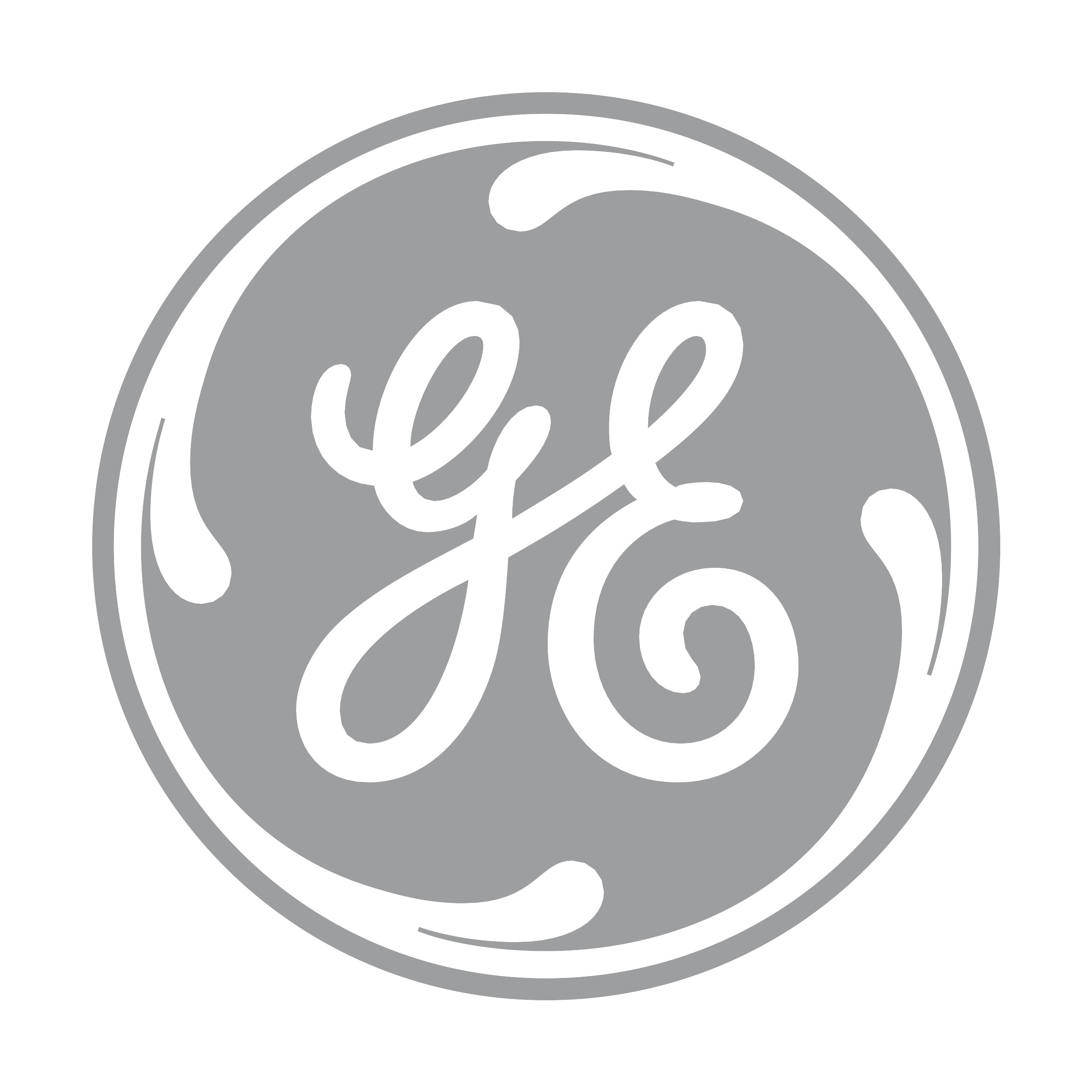
.png)
